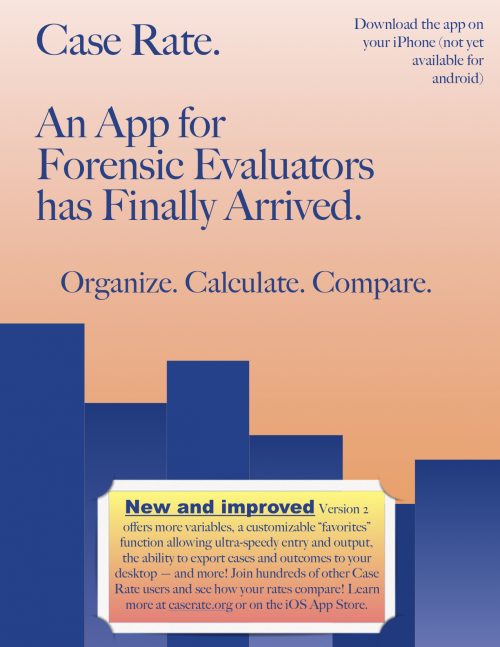About Case Rate
Case Rate (www.caserate.org), developed by Dr. Neil Gowensmith and his team, is the first mobile app ever designed specifically for forensic evaluators. Case Rate provides evaluators with the ability to improve their practice in a number of different ways. The most powerful feature of Case Rate is reviewing the base rates of important facets related to your work – how often you opine someone competent vs incompetent, or how often you’re retained by defense counsel, for example. You can combine variables to see how they impact each other, compare your rates to others using the app, and export all of your information to your desktop. It’s safe and secure, using the industry’s top encryption measures to protect your information. There’s no easier way to organize cases, prep for cross-examination, or investigate factors that could influence your final forensic opinions.
Case Rate was developed by Dr. Neil Gowensmith and his team.
Here’s how the different features of Case Rate can work for you:
Organize
Case Rate is a great way to organize your case-related information. Enter attorney contact info, evaluation details, payment info, contact info for county jails, deadlines, and much more. Now it’s easy to keep all of your case-related information in one spot.
Calculate
Case Rate allows evaluators to enter up to 30 variables related to their cases. Demographics (age, gender, diagnoses, ethnicity of the defendant, etc.), case information (severity of charges, violent or sexual charges, etc.), evaluator information (employer, discipline, etc.), and evaluation information (fees charged, retaining attorney, etc.) can be entered. You choose what to enter – and using our new “favorites” feature, you can pre-select those variables you’re most interested in, making entering case information a breeze.
The most exciting part of Case Rate is analyzing those variables. You can calculate base rates on any of your variables with one click – now you’ll know how many cases you’ve conducted, what your rates of opinions are, how often you’re retained by one party, where you conduct your evaluations, and more. And you can combine variables to explore how your base rates change in certain situations. Want to know if your forensic opinions change when you’re paid a fee, retained by prosecution, or seeing a person of color? More and more often cross-examiners want to know the answers to these questions – now, by creating a “Custom Case Rate” you’ll have the answer and be ready to respond with confidence and accuracy.
Compare
By aggregating data across users, we are able to calculate base rates that are informed by all users. To be clear, we never collect personally identifying information (we couldn’t if we wanted to; it’s encrypted into a random mishmash), but other data is aggregated for analysis of trends, patterns, and larger base rates. We provide those comparative base rates to all users of Case Rate through regular newsletters and updates. In time, when minimum numbers of users allow, more sophisticated analyses will be possible (state by state, discipline by discipline, etc.).
Case Rate is bigger and better than ever! Our latest updates include more variables, the ability to personalize your “favorite” variables and case rate outcomes, and the ability to export all of your data with the click of a button. It’s never been easier to organize your cases and keep track of your findings.
Get Case Rate
Join the many others around the world using Case Rate! Visit us at www.caserate.org or find the iOS app in the App Store for more information (Android version in development).
Translating Research into Practice
“Through development of a TNPS, we hoped to shift the goalpost from an outcome focused exclusively on risk of sexual reoffense (or any nonsexual criminal offense) to an outcome focused on adjustment and health. Although many of the dynamic items used in the TNPS are found in extant juvenile sexual and nonsexual risk assessment scales, our objective in including such items in the TNPS is not to capture risk of reoffense but to guide individualized treatment to reduce risk and develop behaviors and lifestyles that are incompatible with delinquent or criminal behavior. The considerable item overlap with other scales is not coincidence. Understanding risk is a sine qua non for reducing risk; accurately assessed risk is our best guide for identifying optimum interventions tailored to individual needs. In sum, we have argued that our efforts to predict risk reliably have fared poorly and that a far more expedient longterm strategy is to mitigate risk. Further, inclusion of protective factors (items that may mitigate or buffer risk, as well as others that are important for improving treatment response), is intended to promote a dynamic and holistic approach to facilitating positive development, healthy transitions into adulthood, and prosocial lives. By shifting the focus to risk mitigation through treatment we are hoping to influence not just practice but the policy driving practice” (p. 164).
“The TNPS and its guiding principles are not an attempt to devalue assessment of risk, and we are not recommending abandoning risk assessment. Risk is a sensitive barometer for what must be targeted in treatment. However, lessons learned from the past is that risk assessment with juveniles, when treated as an endpoint, is fraught with problems, both substantive (methodological) and practical (management). What we recommend is that risk take its place embedded in the matrix of an idiographic assessment that focuses, as a midpoint, on mitigation through treatment and other interventions that foster health rather than as an end goal of prediction” (p. 164).
“Although the data from our pilot sites will hopefully shed light on our basic assumptions about the efficacy and merits of the TNPS, these assumptions must continue to be examined empirically well after the pilot phase. We should emphasize, however, that the TNPS alone can never mitigate risk, and its assistance with guidance, treatment, and management can be no better than the fidelity with which it is used. The potential implications described below refer to how, if implemented with fidelity, the TNPS might inform decision-making and impact juveniles, their parents and caregivers, child welfare system case workers, law enforcement, probation officers, juvenile court judges and attorneys, teachers and school administrators, clinicians/treatment providers, public policy advocates, and researchers” (p. 164-165).
Other Interesting Tidbits for Researchers and Clinicians
“We have sought to develop and test a different model for addressing the needs of juveniles with sex offenses. This model has three overarching goals: (a) reverse the prevailing standard of practice that understands risk prediction as the quintessential purpose of assessment, (b) reintroduce treatment as the principal objective of sound management, and, in so doing, (c) potentially reduce the large number of false positive decisions (i.e., classifying low risk youth as presenting a high risk), that pose a financial burden on society and may further cripple already troubled youth” (p. 165).
“Our proposal is not novel. Over two decades ago, Chaffin and Bonner (1998) penned their oft-cited Editor’s introduction: “Don’t Shoot, We’re Your Children:” Have we gone too far in our response to adolescent sexual abusers and children with sexual behavior problems? Ten years later Chaffin (2008) wrote his reprise focusing on the continued disconnect between policy-based misperceptions of high risk, homogeneity, and intransigence (the belief that sexually offending behaviors in juveniles are ‘tenacious and difficult to change and require not just specialized intervention but lots of it . . . delivered over a long period of time . . . and should involve more intensive, restrictive, and expensive elements’ [pp. 118–119]). As Chaffin pointed out in 2008, there was no scientific support for those beliefs, a finding that continues to be true today” (p. 165).
“In the decade since Chaffin’s (2008) article, there has been a wealth of empirical literature documenting: (a) heterogeneity among juveniles with sex offenses, (b) low sexual recidivism base rates, implying a low risk of new sex offenses, (c) marked developmental immaturity, indicating that change is inevitable as a mere function of growth, and (d) amenability to short-term treatment; indeed there is evidence that high intensity treatment for low-risk youth may actually increase the likelihood of reoffending. Thus, the TNPS is not an experiment with a new risk assessment scale for JSOs, but rather a structural attempt – and an opportunity – to align policy and practice with scientific evidence. Any steps, even preliminary ones, that lay groundwork for empirically informed policies, management strategies, and treatment methods that reduce a youth’s contact with the juvenile justice or child welfare system will be beneficial for everyone—our juvenile clients, their families and communities, and our society: (p. 165-166).
Join the Discussion
As always, please join the discussion below if you have thoughts or comments to add!








